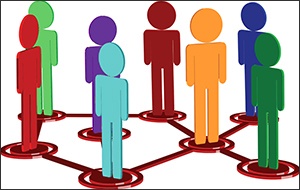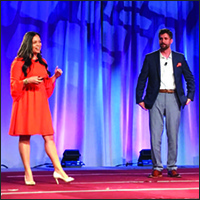 The Cultural Spectrum
The Cultural Spectrum
As printers, or as suppliers to printers, we obsess in the pursuit of perfection– perhaps in no area with so much focus as on the spectrum of color. The perfect color match, the lowest Delta E, correct ink density and a flawless alignment of parts and plates from station to station. All to deliver the exact hues our customers demand. But there is a different spectrum that is perhaps even more difficult to master, and for which alignment is even more critical: the Cultural Spectrum.
People, and the culture they share, are the true core of our businesses. The owners and leaders of the organization who direct our businesses; the employees designing our packaging, running our presses; the vendors and partners supplying us with the tools we need to get the job done; our audience, the manufacturers buying our packaging—these people are all part of a complex cultural spectrum. Each group has its own standards and expectations, its own motivations, and its own collective personality.
Most people, when asked about their company’s culture, are unlikely to think in terms of this entire spectrum and may miss the opportunity to drive greater success. Seeking to create a culture that recognizes and fosters alignment across all of these interdependent work groups is a challenging path, but one with great rewards. We’d like to share with you the story of how our team identified the elements of its own spectrum, as well as the steps we took to pursue alignment across the spectrum.
Our Culture Journey

In 2015, our company, Flexo Concepts, felt a need to work on and improve our culture. But what does that even mean? To us, we wanted to improve employee retention and satisfaction, but really had no idea how to get started. To help us, we engaged a cultural consultant and embarked on a journey so much bigger than just building employee morale. It started with one of those intensive 360° reviews typically done of individuals by persons from every part of their work sphere. For us though, it was a 360° review of our entire business. Customers of all sizes were interviewed to learn the market’s perception of our business. We also went about privately interviewing every single one of our employees—the owners, the guys running our equipment, our accounting team, engineers, customer support—everyone!
The result of this process was not just the most complete view of our business we have ever had. We understood our customers better. We learned firsthand about their perception of our brand, our strengths and our weaknesses and then used a simple Venn diagram to map our capabilities and also those of our competition against the wants and needs of our customers. The areas where our business uniquely supported the customer expectations were defined as our “Points of Distinction” [PODs]. We worked with this information to create a new focus and strategy for the business. For example, one of our PODs is centered around innovation. To grow this strength, we constructed an R&D lab specifically to support application testing and the development of new polymers.
While the PODs gave us a tactical roadmap, we had more work to do to understand and develop our culture. The cultural consultants had helped us to collect and compile information, but for the next 6 months we worked on our own to further grow the concepts. This process was done by way of a biweekly meeting held with the entire management staff. All departments worked together, taking a ground-up approach to write our Vision, Mission and Promise statements. It’s an exercise many organizations go through, but one we took a fanatical approach toward. We had a rule in these meetings that no one was ever to leave in silent disagreement. To say one thing during the meeting, but to act out of synch in the day-to-day would completely undermine the process and would not foster alignment.
People, Trust, Accountability and Performance
Another product of these meetings was a clear definition of our values, organized around four pillars—People, Trust, Accountability and Performance. These values closed the loop of a sort of “corporate operating system,” which we were ready to roll out not just to our organization, but to the rest of the spectrum as well. The efforts to understand and align ourselves to our audience were a good start, but we felt a more  holistic approach would be more effective. To achieve this, we did more than work with our own staff; we reached out to our key vendors as well and educated them on our corporate values. We met with them to find common ground in our values and to get them to understand not just our needs, but the needs of our customers. We felt our own transformation would do little good without the support of our partners. Some suppliers got weeded out in the process, but our supply chain is as strong now as it has ever been.
holistic approach would be more effective. To achieve this, we did more than work with our own staff; we reached out to our key vendors as well and educated them on our corporate values. We met with them to find common ground in our values and to get them to understand not just our needs, but the needs of our customers. We felt our own transformation would do little good without the support of our partners. Some suppliers got weeded out in the process, but our supply chain is as strong now as it has ever been.
With leadership, employees, and our upstream support network now closely aligned, we had to circle back to the final group: the audience. A strong, progressive and uplifting culture is a great asset for an organization, and we wanted to communicate it to our customers—especially because they had been so key in shaping the changes we made. To do this, we boosted our social media presence, opened our business for employee-led tours and started sharing our story: the day-in-day-out ways our culture shapes our business and our interactions with each customer; the journey of continuous improvement that we want our customers to enjoy and benefit from as much as we have.
After a year and a half of work, we found ourselves with the improved culture we had sought, and it extended beyond the sphere of ourselves and our employees. We feel

our culture and values are bigger than ourselves because our Vision and Mission are bigger than ourselves and they require more than what just the people in our building can provide. We recognize that our aspirations require a big-picture perspective, one aligned across the whole spectrum. It is not an impossible task, and though it is one that never ends, it also is one which never stops paying back. We would encourage any team looking to repeat this work for themselves to ask:
- Who is in your Cultural Spectrum?
- Does your Culture value what your Spectrum values?
- Is your Culture aligned through the Spectrum?
If you attempt to honestly and thoughtfully answer these questions, your own cultural reinvention will have already begun!

